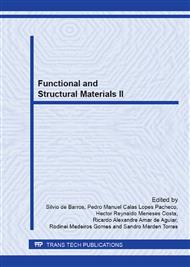[1]
International Association of Classification Societies, W22, Offshore Mooring Chain, June, (2011).
Google Scholar
[2]
AWS 5.5, Specification for low alloy steel electrodes for shielded metal arc welding, (1996)
DOI: 10.22486/iwj.v31i1.177524
Google Scholar
[3]
J.C.F. Jorge et al.: Desenvolvimento de procedimento de reparo por soldagem de amarras de aço para ancoragem de plataformas de petróleo, Anais do XXVII CONSOLDA, Paper 40, Brazil, (2001).
DOI: 10.29327/aconemi.405480
Google Scholar
[4]
J.C.F. Jorge, I.S. Bott, J.A. Suman and L.F.G. Souza: Soldagem & Inspeção Vol.9 n.4 (2004), pp.205-212.
Google Scholar
[5]
J.C.F. Jorge, L.F.G. Souza, P.M.C.L. Pacheco, A.M.F.S. Filho, O.R. Santos Filho, J.L.C. Diniz and I.S. Bott: Evaluation of the mechanical properties of welded links of high strength steel mooring chains after fatigue testing, Proc. of the 2nd Latin American Welding Congress, Paper 66, Brazil (2008).
Google Scholar
[6]
P.M.C.L. Pacheco, P.P. Kenedi, J.C.F. Jorge, E.M.D. Coelho and G.S. Matoso: Modeling the residual life of recovered schackles, Proceedings of 20th International Conference On Offshore Mechanics And Arctic Engineering, Paper 3399, Brazil (2001).
Google Scholar
[7]
P.M.C.L. Pacheco, P.P. Kenedi, J.C.F. Jorge and R.D. Vieira: Residual stress analysis of studless chain links repaired by welding, IN: 27° Seminário de Inspeção de Equipamentos, Brazil (2001).
Google Scholar
[8]
L.E. Svensson: Consumables for Welding High Strength Steels, Svetsaren Vol. 54 (1999), pp.29-33.
Google Scholar
[9]
J.E. Ramirez: Welding Journal Vol. 87 n.3 (2008), pp. 65s-75s.
Google Scholar
[10]
M. Lord and G. Jennings, Effect of interpass temperature on properties of high-strength weld metals, Svetsaren. Vol. 54 (1/2) (1999), pp.53-58.
Google Scholar
[11]
J.E. Ramirez: Welding Journal Vol. 88 n.1 (2009), pp.32-38.
Google Scholar
[12]
E. Surian, N.M. Rissone, H.G. Svoboda and L.A. Vedia: Welding Journal Vol. 89 n.3 (2010), pp. 54s-64s.
Google Scholar
[14]
E. Keehan, L.Karlsoon and H.O. Andren: Science and Technology of Welding and Joining Vol.11 n.1 (2006), pp.1-8.
Google Scholar
[15]
E. Keehan, L.Karlsoon and H.O. Andren: Science and Technology of Welding and Joining Vol. 11 n.1 (2006), pp.9-18.
Google Scholar
[16]
E. Keehan, L.Karlsoon and H.O. Andren: Science and Technology of Welding and Joining Vol.11 n.1 (2006), pp.19-24.
Google Scholar
[13]
G.M. Evans, The Effect of Nickel on the Microstructure and Proprieties of C-Mn All-Weld Metal Deposits, Welding Research Council Bulletin Vol. 37 (2/3) (1991), pp.70-83.
Google Scholar
[17]
B.Y. Kang, H.J. Kim and S.K. Hwang: ISIJ International Vol. 40 n.12 (2000), pp.1237-1245.
Google Scholar
[18]
E. Keehan: Effect of Microstructure on Mechanical Properties of high strength steel weld metals, Ph D Thesis, Chalmers University of Technology (2004).
Google Scholar
[19]
V.B. Trindade, R.P.R. Paranhos, J.C. Payão and L.F.G. Souza: Soldagem & Inspeção Vol. 10 n.4 (2005), pp.164-171.
Google Scholar
[20]
Z. Zhang and R.A. Farrar: Welding Journal Vol. 76 n.5 (1997), pp.183-196.
Google Scholar
[21]
L.E. Svensson: Microstructure and properties of high strength weld metals, Materials Science Forum. 539-543 (2007), pp.3937-3942.
DOI: 10.4028/www.scientific.net/msf.539-543.3937
Google Scholar
[22]
E. Surian, J. Trotti, A. Cassanelli and L.A. de Vedia: Welding Journal Vol. 73 n.3 (1994), pp. 45s-53s.
Google Scholar
[23]
J.C.F. Jorge, J.M.A. Rebello and L.F.G. Souza: Materials Characterization Vol. 47 (2001), pp.195-205.
Google Scholar
[24]
M.H. Avazkonandeh, M. Haddad-Sabzevar and A. Haerian: Journal of Materials Science Vol. 44 n.1 (2009), pp.186-197.
Google Scholar
[25]
G.M. Evans: The Effect of Chromium on the Microstructure and Properties of C-Mn All-Weld Metal Deposits. Welding Research Council Bulletin Vol.37(1991), pp.56-69.
Google Scholar


